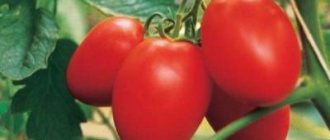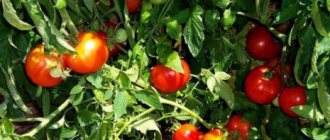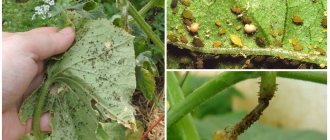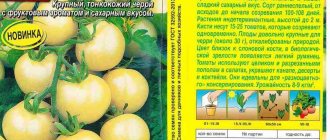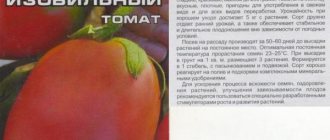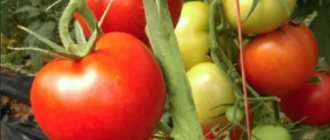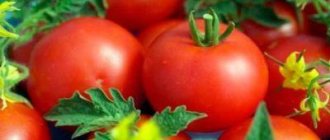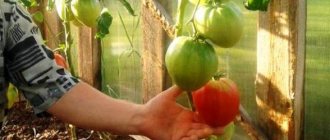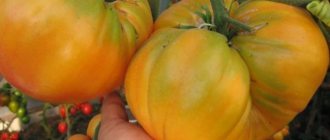Detailed description and characteristics of the Kolkhoz fruitful tomato variety
The most popular among gardeners are varieties that can be grown both in greenhouses and in open beds. High yield is one of the main criteria for evaluating a tomato. The Kolkhoz fruitful variety, or, as it is also called, Kolkhoznitsa, fully lives up to its name. You will find a description of the characteristics of tomatoes in the article.
Description and characteristics of the tomato variety Kolkhozny productive
This variety belongs to the varieties of medium ripening period. Tolerates dry weather and low temperatures well. The bush is branched, semi-spreading, reaching a height of 60 centimeters to 1 meter. The ripening period is 100-110 days. The fruits are round in shape, red in color, the flesh is dense, the taste is sweet and sour. The weight of the fetus ranges from 95 to 115 grams.
Tomato bush with ripe fruits
Advantages and disadvantages
The advantages of the variety include:
- high yield;
- high content of microelements and vitamins;
- excellent taste;
- versatility of use;
- resistant to weather changes;
- ease of care;
- high resistance to diseases;
- good transportability;
- not prone to cracking;
- good presentation;
- stable harvest;
- simultaneous formation of fruits;
- the ability to grow both seedlings and non-seedlings.
Seed preparation
Good seedlings can only be grown from seeds that are properly prepared for sowing. Preparation is carried out in several stages:
- Seed selection . To select high-quality seeds, you need to pour a solution of table salt into a glass jar and dip the seeds in it for a few minutes. Throw away the seeds that rise to the surface, and rinse thoroughly under running water those that sink to the bottom.
- Disinfection . In order to prevent diseases, the seeds must be soaked for 15 minutes in a 1% solution of potassium permanganate, or in a 2% solution of hydrogen peroxide for 10 minutes. The seeds are then treated with a growth stimulant.
- Soak. After processing, the seeds are wrapped in a cloth and immersed in a glass container with water so as to cover only half the seeds. The soaking procedure is carried out for 10 hours. Remove the napkin with seeds from the water three times, replace the water, and let the seeds air out.
- Germination . In order for the seeds to give better germination and an earlier harvest, they must be germinated before planting in the soil. Place the soaked seeds on a damp cloth and leave until sprouts appear. It is necessary to ensure that the napkin is always damp. The room temperature should not be lower than +20 degrees.
- Hardening . The final procedure for preparing seeds is hardening. This procedure is performed so that the seedlings adapt well to weather changes and produce a better harvest. After germination, place the seeds in the refrigerator for 14 hours (temperature no higher than +2 degrees). Then they warm up for 14 hours (temperature not lower than +22 degrees).
Potassium permanganate solution for seed disinfection
Growing tomato seedlings
Sowing of seeds must be done in the last days of February. Before sowing seeds, it is necessary to prepare special soil. To do this, mix equal parts of soil from the garden, sifted river sand, and peat.
To normalize acidity, add 200 grams of ash. Before planting, the soil must be disinfected with a strong solution of potassium permanganate or heated on the stove. The finished soil is poured into oblong wooden containers, leveled and holes made 1 cm deep.
The sprouted seeds are placed in grooves at a distance of 2 cm from each other, sprinkled with soil and lightly compacted. The thickness of the soil is 0.5 cm. The soil is carefully watered, covered with glass and taken out to a dark room with a temperature of +25 degrees.
After 5 days, when the first shoots appear, remove the glass and move the boxes with seedlings to a room with good lighting. After the seedlings have 2 leaves, they must be transplanted into separate 1-liter pots.
Tomato seedlings Kolkhoz productive
Replant the seedlings carefully, with a clod of earth, so as not to damage the fragile root system. After transplanting, the seedlings are fertilized with a solution of fermented cow manure or chicken droppings. Mullein is bred in a ratio of 1:10, chicken manure is 1:15. Fertilizing should be repeated 30 days after emergence, and the next one should be done 15 days after the second.
A week before transplanting to open beds, seedlings need to be hardened off. To do this, take the pots with seedlings outside for 2 hours for the first two days. Then the seedlings are left outside throughout the daylight hours. 2 days before planting on the garden bed, do not bring it into the room at night.
Planting in open beds
The seedlings are transplanted into the beds in mid-May. The area where seedlings are planned to be planted should be well lit by sunlight.
In the prepared soil, dig holes at a distance of 70-90 cm from each other, and there should be at least 1 meter between the rows. Keeping seedlings closer to each other will reduce yields and increase the risk of disease.
The bows must be deep so that the root fits freely with a lump of earth and the trunk is buried to the lower leaves. Sprinkle the hole with earth, tamp it down lightly, and make grooves around the hole for watering. After transplanting, the seedlings should be watered abundantly. This will help the seedlings take root well. After some time, the bush must be tied to a support at a height of 15-20 cm.
Seedling care
During growth, seedlings require a set of care measures:
- Removing weeds that take nutrients from the soil.
- Perform mulching.
- Constant timely watering (the soil must be moist). Excess moisture will cause the roots to rot. Watering should be done early in the morning.
- Pinching shoots (leave the bush with one or two stems).
- Removing all lower shoots and leaves at a height of 20 cm.
- Timely treatment of seedlings to prevent diseases.
Tomato “Kolkhozny” - characteristics of the variety
The choice of tomato variety for planting should be approached with special care. The result of the harvest will depend on this. Domestic breeders created and presented to summer residents and gardeners a variety that has many useful properties. The Kolkhoz tomato is noted for its high yield, excellent taste and can be grown in various types of conditions.
Features of the variety
Like any variety of tomatoes, the product of Russian breeders is endowed with its own characteristics, which include:
- The presence of abundant vegetation;
- Low bush height;
- Average fruit size;
- Medium type of maturation;
- Wide range of purposes.
The bush of these tomatoes is characterized by abundant vegetation. Bushes have many branches.
The height of the bush varies from half a meter to a meter. The average height of Kolkhozny is approximately 0.6 meters.
The fruits are medium in size and have a round shape. They have a glossy red color. The tomato skin is quite thick, dense, without roughness. Tomatoes of this variety are sweet, with a subtle sourness. A tomato weighing between 90 and 120 grams is considered normally ripe. Full maturity is achieved after three months from the date of planting.
Kolkhozny variety tomatoes have a wide range of uses. They are eaten fresh and also used for processing. Canning, preparing tomato paste, drying - all this is excellent for processing this berry.
Advantages and disadvantages
These tomatoes have virtually no flaws and are characterized by many excellent characteristics. Main advantages:
- Excellent productivity;
- Great taste;
- Versatility of fit;
- Long shelf life;
- Resistance to diseases;
- Drought tolerance;
- Matching in maturation.
The main and main indicator by which the Kolkhoz tomato is characterized is excellent yield. The average yield varies from 3 to 6 kilograms of tomatoes per fruiting bush.
The sweet taste of the fruit is suitable for widespread use and consumption. A slight sourness adds piquancy and only improves its taste.
Excellent preservation is achieved thanks to the dense and thick peel. This characteristic allows vegetables to be transported over long distances.
Immunity to diseases is another undeniable advantage of the Kolkhoz variety. Brown spot and late blight are not at all dangerous for it.
Dry weather is not a negative factor for him. This berry tolerates lack of moisture and watering well.
The fruits form and ripen at the same time.
Features of care
Collective farm is characterized by the versatility of planting. It can be planted in greenhouses, greenhouses, and also in open ground. Main comprehensive care measures:
The Kolkhoz tomato, distinguished by its excellent yield and ease of care, has deservedly earned the respect of summer residents and gardeners.
Growing technique
The Kolkhoz tomato variety is not demanding in cultivation and is resistant to pests and diseases. The main rule is to follow the growing technique. The crop grows well on light, highly fertile soils.
Attention! Cabbage, carrots, legumes, onions, and cucumbers are considered good predecessors of tomatoes.
Growing the crop in stages:
- seed preparation;
- growing seedlings;
- planting in beds;
- seedling care.
Growing tomatoes Kolkhoznitsa
Proper preparation of seed material is a guarantee of healthy seedlings. First of all, choose good seeds, which are soaked for a couple of minutes in water with salt. Those seeds that have sunk to the bottom of the container with the solution are selected for planting. They are washed with plain water and disinfected.
To ensure that the seedlings do not suffer from diseases, grow quickly, and develop the root system, the seeds are soaked for half an hour in potassium permanganate, and sometimes hydrogen peroxide is used. After this, the seed is treated with a growth stimulator.
The treated seeds are wrapped in cloth and immersed half in water. Leave for 10 hours. During this time, the water is changed three times, the seed is shaken and ventilated from time to time.
Important! In order for the farm variety to begin to bear fruit faster, preliminary germination of the seeds is required. The seed material is laid out on a well-moistened cloth and left to germinate in a warm room. The fabric should be constantly damp.
The final stage of seed preparation is hardening. The process is necessary in order to improve yields and prepare the crop for negative weather conditions. Sprouted seeds are placed in the refrigerator for 12-14 hours, after which they are removed and warmed for the same time. The temperature in the refrigerator should not exceed +2 degrees, and when heating the seeds, not lower than +22 degrees.
Planting seedlings
Note! The presented tomato variety is sown as seedlings at the end of February. Sprouted seeds are planted in pre-prepared soil made of peat, river sand and earth. The soil is fertilized with wood ash, steamed with potassium permanganate or fried in the microwave.
The earth is poured into oblong-shaped containers; these can be wooden boxes, made by hand or purchased. Furrows are made in the ground, the sprouted seeds are laid out loosely, carefully covered with 0.5 centimeters of soil and lightly compacted. After the work is completed, the soil is moderately watered, the seedlings are covered with glass and taken to a dark but very warm room for 5-6 days.
After the first shoots appear, the containers are transferred to a well-lit room and the glass is removed. When 2 leaves appear, the seedlings are transplanted into separate cups or peat pots. Transplantation is carried out carefully, with a lump of earth, since the plants’ root systems are still weak.
Planting tomato seedlings in the ground
The seedlings are fertilized with diluted chicken droppings (1:15) or mullein (1:10). Fertilizers are applied three times. Before planting seedlings in open ground, they are hardened off for a week.
Planting in the garden
Hardened plants aged 55-70 days are planted in beds when the threat of late frosts has passed, approximately in the second half of May. Planting is carried out in areas well lit by the sun; the soil is first dug up and fertilized with minerals and wood ash.
The productive variety is planted in the ground, observing the interval. The distance between plants is 70-90 centimeters, between beds – 1 meter. After planting, the seedlings are well watered for better rooting and adaptation in the soil.
Important! The presented variety needs regular and abundant watering with warm water, in the evening or early morning. Feeding is carried out three times a season.
As the crop grows, the bush is formed into one stem. Despite its short stature, the bush is tied to a trellis. The brushes are also tied up so that when large fruits form they are not injured. To increase fruit formation, pinching is carried out. To avoid thickening of the planting, the lower foliage from the bushes is torn off to a height of 20 centimeters.
Rules for a good harvest:
- weeding;
- mulching the soil;
- do not allow the soil to dry out or become waterlogged;
- bush formation;
- pinching, removing foliage from the lower part of the plant;
- prevention from diseases and pests.
You can enjoy delicious, aromatic fruits 100 days after planting the seedlings. Growing collective farm tomatoes is not difficult even for novice gardeners. The culture is unpretentious, which is why it has earned the love of many gardeners.
The choice of tomato variety for planting should be approached with special care. The result of the harvest will depend on this. Domestic breeders created and presented to summer residents and gardeners a variety that has many useful properties. The Kolkhoz tomato is noted for its high yield, excellent taste and can be grown in various types of conditions.
Tomato Kolkhozny - description and characteristics of the variety
The Kolkhoz tomato is a determinate, high-yielding ancient variety. It is grown mainly in open ground. Low branched bushes practically do not need tying up and shaping. The variety is resistant to tomato viral diseases and blossom end rot. The fruits do not crack, have red juicy pulp and dense skin.
Description
The Kolkhozny variety is one of the most productive varieties of tomatoes for open ground. The plant is spreading, stocky, completely covered with ripening fruits. Leaves are rich green. The fruits are round in shape, with thick skin, all of the same size.
Ripe fruits are easily transported over long distances. This variety of tomatoes is very popular among rural residents for their unpretentiousness and high yield, as well as the fact that they can be used to collect seeds for cultivation in subsequent years on their plots. Tomatoes are canned and processed into juice, paste, and ketchup. Kolkhoz variety tomatoes are also good for pickling.
Growing and care
If it is possible to provide good lighting, tomato seeds can be planted in boxes as early as the end of February. In its absence, it is better to postpone sowing to the beginning of March, since the presence of sunlight greatly affects the growth and strength of seedlings.
- Before planting, it is recommended to disinfect the seeds in a solution of potassium permanganate. Since the seeds are small, they should not be covered with soil. The best option would be if, after watering the soil well, sow them from above, and then cover them with film. This is necessary to avoid loss of moisture, which is needed for germination.
- After this, every day you should spray with a spray bottle, since regular watering will wash out all the seeds. If the temperature is within 20-22 degrees, then with such care, seedlings will appear in 5-7 days, which must also be continued to be looked after.
- As they grow, you should open the film more and more often, allowing the sprouts to get used to the surrounding conditions. You should start with once a day for a period of no more than 10 minutes, increasing this time every week. After the seedlings get stronger and their first leaves grow, it will be possible to completely remove the film and pick.
Description of the Kolkhoz tomato variety, its characteristics and yield
The tomato takes pride of place in the garden beds of most Russian gardeners. The beneficial properties and good taste of the fruit encourage breeders to create more stress-resistant and productive varieties. The Kolkhoz productive tomato already contains its main advantage in its name. The work of domestic selection will delight lovers of varieties with high-yielding qualities.
General information about tomato
The plant from the originator “Kolkhoznik” is recommended for open soil. The limitation is relative; if grown in a greenhouse, the tomato can show high yields.
Description of the variety and external features:
- Mid-season, reaches technical maturity on average after 100 days from planting.
- Medium-fruited.
- Compact, spreading bush of medium power.
- The height of the bush does not exceed 60 centimeters.
- The bush is abundantly covered with green leaves.
- Stable immunity to late blight and brown spot.
- High yield.
- Endurance.
- Good tolerance to dry conditions.
- Cold resistance.
- Simultaneous harvesting.
- Well preserved.
- Transportability without compromising the appearance of the fruit.
The expansion of the zoning zone beyond the borders of the native land is confirmed by reviews of Ukrainian and Moldavian gardeners. Characteristics and external data of the fruit:
- Round form.
- Ribbed.
- Glossy.
- The average weight does not exceed 100 grams.
- Thick, smooth skin.
- Red color when mature.
- Persistent tomato aroma.
- High density.
- Sweet taste, no sourness.
- They are not prone to cracking.
- Universal purpose.
Tomato fruits of the Kolkhozny variety are suitable as raw materials for tomato products. The berries can be used for drying, pickling, twisting and fresh consumption.
Recommendations for agricultural technology
The originator allows seedling and non-seedling planting methods. If you choose the first option, the harvest is harvested 1–2 weeks earlier. Seedling preparation should begin depending on the climatic conditions of cultivation, from early February to April.
IMPORTANT! Before planting, the seed material must be prepared and soaked in a disinfectant composition.
When planting in the ground, seeds should be placed at a depth of 2–3 centimeters. After the first two leaves appear, the plant should be pruned. Tomato bushes should be sparsely arranged; the number of bushes per square meter should not exceed 6 pieces. When choosing a seedling method, it is necessary to harden off the plants before sowing. This unpretentious variety requires compliance with the classical rules of agricultural technology: timely watering, loosening, application of complex mineral fertilizers, and removal of weeds.
Gardeners' opinion
Good day! For two summer seasons I have been planting a productive Kolkhoz tomato. I give the yield of the variety a plus. The berries are ready for picking 100–115 days from the date of planting. The tomatoes are all smooth, with sweet flesh, and medium in size. Suitable for twists and fresh consumption. I didn’t find any cons for myself. I recommend it to everyone!
Valentina Vavilova, 53 years old
Good afternoon! I spent a long time choosing a tomato that is suitable for open ground. Last summer I found the productive variety Kolkhozny. The plant lived up to its name; given the cool summer, we managed to get a decent harvest. The plant is not fussy to care for; a novice gardener can handle it.
“Collective farm productive”: sustainable and highly productive
For those who prefer products from their own garden to store-bought vegetables, which are suspiciously beautiful for being natural, the problem of choosing a variety is well known, because now in specialized stores one’s eyes literally run wild from the variety of bright envelopes with seeds. Try growing tomatoes of the “Collective Farm Harvest” variety - we guarantee you won’t regret it!
Description
The bush of these tomatoes is spreading, of medium thickness, densely and abundantly covered with leaves and low - no higher than 0.6 m.
The tomatoes themselves are round in shape, with smooth skin and dense flesh, an appetizing red color and quite impressive in size: the average weight of one tomato is from 80 to 100 g or a little more. According to the generally accepted classification, such a tomato is classified as medium-fruited (for reference: this group includes tomatoes weighing from 70 to 120 g).
The fruits have a good taste and are suitable for fresh consumption, pickling or making juice.
However, any summer resident is primarily interested not so much in the external description of the vegetable, but in its productive qualities, endurance, resistance to natural conditions, diseases and pests, as well as other purely mercantile things. Let’s see what the “Collective Farm Harvest” tomato can boast of in this regard.
Characteristics of the variety
As the name suggests, we are talking about a fertile variety that will delight its owner with a large number of tomatoes.
Productivity is one of the main indicators by which varieties of certain vegetables are classified. According to average indicators, tomato varieties that produce at least 3 kg of fruit from one bush are considered high-yielding.
Tomatoes of the “Kolkhozny Harvest” variety tolerate both dry summers and late spring colds. The fruits reach technical ripeness approximately one hundred days after planting or a little more, which allows the variety to be classified as a medium-ripening variety (although the manufacturer usually characterizes it as mid-early). Given the average early maturity, such tomatoes can be grown both in seedlings and without seedlings, immediately sowing the seeds in open ground. However, you need to understand that in the latter case the harvest will ripen a little later (everything in this world is relative: a mid-season variety, lovingly grown from seedlings, has every chance of taking the palm in terms of ripening speed from its super-early brother, sown directly in the garden bed).
Advantages and disadvantages
In order to evaluate the advantages and disadvantages of a variety, there is very little theory (or rather, a history of what the so-called “yield tomatoes” are).
These tomatoes are an ideal raw material for juices, tomato pastes, and canning; however, true connoisseurs of the subtle taste of ripe tomatoes should opt for more noble options.
The short stature and compactness of the bush are also a tribute to Soviet tradition: there was no talk of any manual gartering of tomatoes on collective farms, and the plant should not fall to the ground under the weight of tall branches hung with fruits, since, in contact with the ground, the fruits were affected by diseases , and the party of the people could not allow this.
A strong and fairly dense peel is a disadvantage and an advantage at the same time. If you don’t squeeze the juice out of a tomato, but, say, use it in a salad, the thick skin has a negative impact on the overall impression of taste. But such tomatoes can be transported over long distances without loss and stored for more than one day.
Among the advantages of the variety, the simultaneous ripening of fruits is also noted, although here, too, different attitudes are possible - in certain cases, it is much more valuable for a summer resident to have a bush in the garden from which he can pick several fruits all summer, rather than three kilograms at a time.
But the undoubted advantages of the variety include its resistance to such sworn enemies of nightshades as late blight and brown spot.
Features of agricultural technology
Since the variety is not capricious, the rules of agricultural technology are quite standard. Such tomatoes prefer soil with a high sand content (light), well fertilized with organic and mineral fertilizers.
In both the first and second cases, the seeds must be soaked in special disinfectants before planting (as people say, pickle). For these purposes, a weak solution of potassium permanganate or, in the absence of such, hydrogen peroxide (2%) is used. After this, modern technologies involve keeping the seeds for 12 hours in nutrient solutions (they are sold in assortment in specialized stores).
In open ground, seedlings are planted at a distance of 30-40 cm from each other with a row spacing of at least 0.7 m. If there is a fear that at night the temperature may still fall below a comfortable minimum, it is worth covering the young bushes with film for the first time; be afraid to land a little earlier (for the middle zone - already in mid-May).
It is recommended to form the “Collective Farm Harvest” tomato bush into one stem. To prevent the plant from falling under the weight of fairly large fruits, as it grows, the bush should be tied to a vertical or horizontal support.
The “Collective Farm Harvest” tomato is a good choice for those who do not have high demands on the taste of the fruit and are willing to sacrifice taste for the sake of a high yield with minimal costs and risks (cold or drought, disease, etc.). This variety can also take pride of place in the garden as a source of good quality raw materials for home canning, including the preparation of tomato juice.
How to grow tomatoes
After 2 months, the seedlings are transplanted into the ground. By this time, the bushes have 5-7 true leaves and fully formed young roots.
Landing
Choose a place for the beds that is sunny and protected from drafts. The holes are made in advance, no deeper than 20 cm, at the bottom of which a little mineral fertilizer is placed. Replant in the evening or on a cloudy day, so the young bushes will quickly get used to the new conditions.
Planting pattern: 40 cm – distance between seedlings, 70 cm – row spacing. For 1 sq. m place no more than 6 plants.
After transplanting, the holes are watered generously with warm, settled water and the seedlings are left to adapt to street conditions for 8-10 days.
Further care of the Kolkhozny fruitful variety
Regular watering is carried out no more than 2 times a week, increasing the frequency only on dry days. Until the seedlings take root completely, it is important to ensure that the soil does not dry out. Water with warm, settled water, strictly at the root, without getting on the leaves in the morning or evening.
After watering, the soil is loosened and all weeds and roots are removed. Weeds are a breeding ground for infections; pathogenic spores and many pests successfully reproduce in them, so they must be removed from the beds without fail.
To retain moisture, the beds are mulched with peat or straw. Mulching also performs a preventive function, preventing insect pests from reaching the root system.
Fertilizing is applied three times per season. As fertilizers, a full complex of mineral fertilizers or organic matter is used. From organic matter, mullein infusion or bird droppings are used in a ratio of 1:15.
The first time is fed during the budding period, the second time is applied during the formation of the ovaries, and the third time is fed during the fruiting period. At this time, potassium salts are added to accelerate the ripening of fruits.
Features of cultivation and possible difficulties
Despite its small growth, the crop is tied to wooden or metal supports installed next to the bushes during transplantation. An unfixed, fragile stem will not be able to withstand the weight of fruitful branches. It is fixed almost immediately after transplanting the seedlings into the ground. As the branches grow and develop, they are also tied to a support so that as the vegetables ripen, their integrity is not compromised.
In addition to vertical support, horizontal trellises are often installed in the garden. To do this, metal supports are mounted on different sides of the bed and a wire is pulled between them, to which the stem and branches are fixed with soft fabric tapes.
For the greatest quantitative indicator, the culture is formed into 1 or 2 trunks. To do this, remove all excess shoots, leaving them only under the first and above the second flower brush. The lower leaves are also removed so that they do not come into contact with wet beds and do not serve as an obstacle to receiving the required amount of light.
Diseases and pests
The culture is distinguished by its stable immunity to many diseases, in particular late blight. Nevertheless, experienced vegetable growers do not forget about preventive measures, thereby further strengthening the plant’s immunity.
Prevention includes:
- moderate watering;
- systematic loosening;
- weed removal;
- ventilation of closed structures (if the crop is planted in a greenhouse);
- treating the land with copper sulfate.
These same preventive measures protect against pests that are dangerous to tomato bushes. But often prevention alone is not enough and pests still appear in the beds.
The drug “Prestige” will help in the fight against the Colorado potato beetle, which is used to spray entire plants.
Important ! If potatoes are planted next to tomatoes, they are processed first. Often it is potatoes that act as carriers of diseases and pests.
Planting sharp-smelling herbs next to the bushes will protect them from many insects, since most of them do not like strong odors. Additionally, pheromone traps are installed for the whitefly butterfly. They attract pests, but are completely safe for other insects.
